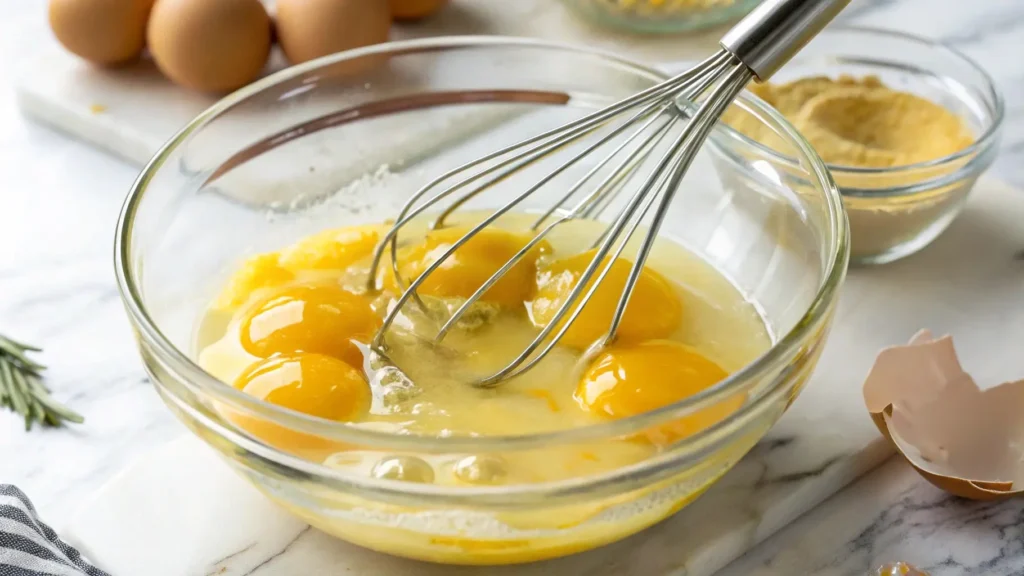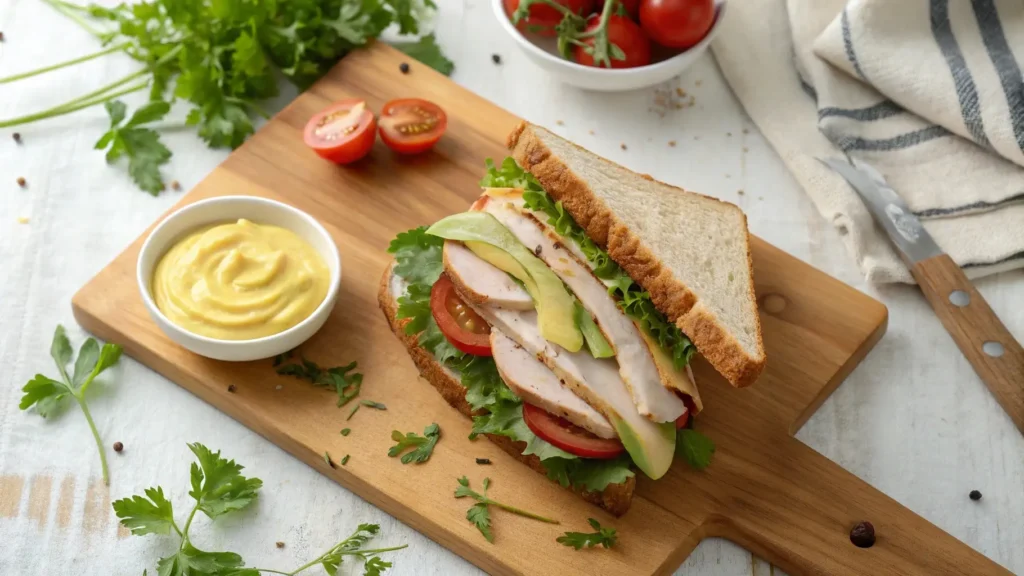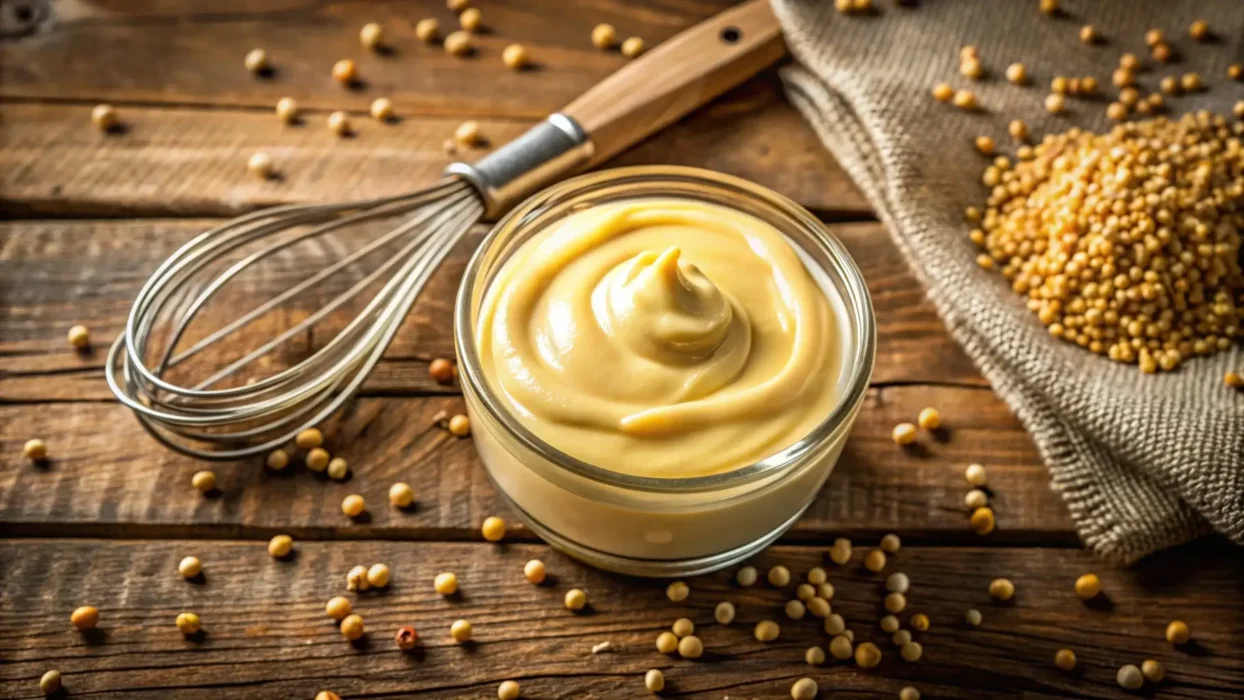Let’s face it—mayonnaise is one of those kitchen staples we all have in our fridge, but have you ever stopped to wonder why so many recipes call for mustard in it? I mean, it’s not like mayo needs a lot of help, right? But trust me, there’s a reason mustard is often the secret star in this creamy condiment. Today, we’re breaking it all down: the science, the history, and the flavor magic behind why mustard and mayonnaise are such a dream team. Ready? Let’s get into it!
Table of Contents
The Role of Mustard in Mayonnaise

So, why exactly does mustard show up in so many mayo recipes? It’s not just for flavor (though that’s a big part of it). Mustard actually plays a pretty important role in making mayo the smooth, creamy spread we all love. Let’s break it down.
What is Emulsification?
Okay, first things first—emulsification. Sounds fancy, but it’s just the process of mixing two liquids that don’t normally want to stay together, like oil and water. In mayo, you’re combining oil with egg yolks and a bit of acid (like vinegar or lemon juice). Without something to hold it all together, the oil and water would separate faster than you can say “salad dressing.” That’s where mustard comes in.
How Mustard Enhances Emulsification
Here’s the cool part: mustard contains natural emulsifiers, like lecithin, which help bind oil and water together. Think of it as the peacekeeper in the mayo-making process. It keeps everything smooth and stable, so you don’t end up with a greasy, separated mess. Honestly, it’s like mustard was made for this job.
Key Components of Mustard in Mayo
Mustard isn’t just a one-trick pony, though. It brings a few key things to the table:
- Flavor: A tangy, slightly spicy kick that balances the richness of the mayo.
- Texture: It helps create that thick, creamy consistency we all love.
- Stability: Keeps your mayo from breaking, even if you store it for a while.
Historical Background
Now that we’ve covered the science, let’s take a quick trip back in time. Because, you know, mayo and mustard didn’t just meet by accident—there’s a whole story behind this iconic duo.
Origins of Mayonnaise
Mayonnaise has been around for centuries, with its roots tracing back to 18th-century France. Legend has it that the French chef of the Duke of Richelieu whipped up the first batch as a victory celebration. Over time, it spread across Europe and eventually became a global favorite. But back then, it was pretty basic—just egg yolks, oil, and vinegar.
When Mustard Met Mayonnaise
Mustard, on the other hand, has been a culinary staple for way longer—like, ancient Rome long. But it wasn’t until the 19th century that mustard started showing up in mayo recipes. Chefs realized that adding mustard not only improved the texture but also gave the mayo a more complex flavor. And honestly, once they tried it, there was no going back.
Flavor Enhancements
Alright, let’s talk about the best part: flavor. Because let’s be real, mustard isn’t just there for science—it’s there to make your taste buds happy.
The Tangy Edge of Mustard
Mustard brings a tangy, slightly spicy kick to mayo that cuts through the richness. It’s like adding a little zing to an otherwise mellow condiment. Whether you’re using Dijon, yellow mustard, or something fancier, that tangy edge is what takes mayo from “meh” to “wow.”
Complementary Flavors
But mustard doesn’t just stop at tanginess. It also adds depth and complexity to the flavor profile. Depending on the type of mustard you use, you might get hints of sweetness, heat, or even a bit of earthiness. It’s like a flavor boost that makes mayo way more interesting. Plus, it pairs perfectly with everything from sandwiches to potato salad.
The Science Behind Mustard in Mayo
Okay, let’s geek out for a second. Mustard isn’t just a flavor powerhouse—it’s also a science superstar when it comes to making mayo. Here’s how it works.
Stabilizing Properties
Mustard is like the glue that holds mayo together. It contains natural emulsifiers, like lecithin, which help bind oil and water. Without it, your mayo would separate faster than a cheap salad dressing. So, if you’ve ever wondered why your homemade mayo stays creamy and smooth, you can thank mustard for that.
Chemical Reactions Explained
When you mix mustard into mayo, it’s not just about texture—it’s also about chemistry. Mustard’s compounds interact with the egg yolks and oil, creating a stable emulsion. This means your mayo stays thick and spreadable, even after sitting in the fridge for a while. Science for the win!
Nutritional Benefits of Mustard
Now, let’s talk about why mustard isn’t just good for your mayo—it’s good for you, too. Spoiler alert: it’s way more than just a condiment.
Low-Calorie Flavor Boost
If you’re watching your calories, mustard is your best friend. It adds a ton of flavor without packing on the calories. A teaspoon of mustard has, like, almost no calories, but it can transform a bland dish into something amazing. It’s the ultimate hack for keeping things tasty and light.
Mustard’s Vitamin and Mineral Content
Mustard is also packed with nutrients. It’s a good source of selenium, magnesium, and omega-3 fatty acids. Plus, it’s got a decent amount of fiber. So, when you add it to mayo, you’re not just getting flavor—you’re getting a little nutritional boost, too.
Health Benefits of Mustard in Mayonnaise
Here’s where things get really interesting. Mustard isn’t just tasty—it’s got some legit health benefits. Let’s break it down.
Anti-Inflammatory Properties
Mustard seeds contain compounds that have anti-inflammatory effects. This means they can help reduce inflammation in your body, which is great for things like joint pain or even just general wellness. So, that mustard in your mayo? It’s doing more than just tasting good.
Digestive Health Benefits
Mustard can also help with digestion. It stimulates the production of digestive enzymes, which can make it easier for your body to break down food. So, if you’ve ever felt like mayo sits heavy in your stomach, adding mustard might actually help.
Culinary Applications of Mustard in Mayonnaise

Now that we’ve covered the science and health stuff, let’s talk about how to use mustard-mayo in your cooking. Spoiler: it’s way more versatile than you think.
Creating Gourmet Sandwiches
A mustard-mayo blend is the secret to next-level sandwiches. Spread it on a turkey club, a veggie wrap, or even a classic BLT, and you’ll instantly take your sandwich game up a notch. It’s creamy, tangy, and just plain delicious.
Pairing Mayo-Mustard Blends with Recipes
This combo isn’t just for sandwiches, though. Try it as a dip for fries, a dressing for coleslaw, or even as a base for potato salad. It adds a tangy kick that pairs well with so many dishes. Honestly, once you start using it, you’ll find a million ways to work it into your meals.
Tips for Making Homemade Mustard-Mayonnaise
Ready to make your own mustard-mayo at home? Here are some tips to help you nail it.
Choosing the Right Mustard
Not all mustards are created equal. For a classic mayo, Dijon mustard works great. If you want something milder, go for yellow mustard. And if you’re feeling adventurous, try whole-grain mustard for a bit of texture. The key is to pick one that matches the flavor profile you’re going for.
Balancing Flavors
When making mustard-mayo, start with a small amount of mustard and taste as you go. You can always add more, but you can’t take it out once it’s in there. Aim for a balance where the mustard adds a tangy kick without overpowering the creamy richness of the mayo.
Common Mistakes When Adding Mustard to Mayo
Even though it’s pretty simple, there are a few pitfalls to avoid when making mustard-mayo. Here’s what to watch out for.
Overpowering the Mixture
It’s easy to get carried away with the mustard, but too much can make your mayo taste sharp and overwhelming. Start small and add gradually until you hit the perfect balance.
Using the Wrong Type of Mustard
Not all mustards work well in mayo. Avoid super spicy or overly pungent varieties unless you’re going for a specific flavor. Stick to classic options like Dijon or yellow mustard for the best results.
FAQs About Mustard and Mayonnaise
Alright, let’s tackle some of the most common questions people have about mustard and mayonnaise. Whether you’re a mayo-making pro or just curious about the whole mustard thing, I’ve got you covered. Let’s get into it!
Why is mustard used in mayonnaise recipes?
Great question! Mustard isn’t just there for flavor—it’s a multitasker. It helps with emulsification, which is the process of blending oil and water (or in this case, oil and egg yolks) into a smooth, stable mixture. Without mustard, your mayo might separate or turn out too runny. Plus, it adds a tangy kick that balances the richness of the mayo. Win-win!
Can you make mayonnaise without mustard?
Absolutely! Mustard isn’t a must-have ingredient, but it does make the process easier and the result tastier. If you skip the mustard, you’ll need to rely more on the egg yolks to stabilize the emulsion. Just keep in mind that your mayo might have a milder flavor and a slightly different texture.
Does mustard affect the shelf life of mayonnaise?
Not really. Mustard doesn’t make mayo last longer or spoil faster. The shelf life of mayo mostly depends on the freshness of the eggs and how it’s stored. Keep your mayo in the fridge, and it should stay good for about 1-2 months. Homemade mayo, though, usually lasts about a week because it doesn’t have preservatives.
What type of mustard works best in mayo?
It depends on the flavor you’re going for!
- Dijon mustard: Perfect for a tangy, slightly sharp flavor.
- Yellow mustard: Milder and great for a classic, crowd-pleasing mayo.
- Whole-grain mustard: Adds a bit of texture and a rustic flavor.
- Spicy mustard: If you like a little heat, go for it!
Just avoid super strong or overly spicy mustards unless you want your mayo to have a bold, in-your-face flavor.
Is mustard-mayo healthy?
It can be! Mustard is low in calories and packed with nutrients like selenium, magnesium, and omega-3 fatty acids. When you add it to mayo, you’re boosting the flavor without adding a ton of extra calories. That said, mayo is still high in fat, so moderation is key. If you’re watching your diet, try using a lighter mayo or making your own with healthier oils.
How much mustard should you add to mayo?
Start small—about 1 teaspoon of mustard per cup of mayo is a good rule of thumb. You can always add more if you want a stronger flavor, but it’s hard to fix if you add too much. Taste as you go and adjust until it’s just right for you.
Conclusion
So, there you have it—everything you need to know about why mustard and mayo are such a perfect pair. From its role in emulsification to its tangy flavor and health benefits, mustard is way more than just a condiment. It’s a key player in making mayo the creamy, delicious spread we all love.
Whether you’re making your own mayo at home or just curious about what’s in your store-bought jar, now you know the scoop. Mustard isn’t just an add-in; it’s a game-changer. Next time you spread that tangy, creamy goodness on your sandwich, you’ll appreciate it even more.

